Silvacane Abbey
Gallery of 15 photos for Silvacane Abbey
This former 12th-century Cistercian monastery on the plains of the Durance northwest of Aix-en-Provence is the least active the "three sisters of Provence". Only recently restored, Silvacane is no longer a working abbey or a church. Although empty, the abbey is an excellent example of the beautiful Romanesque style architecture and the historical image of the Cistercian life.
Lérins Abbey | Sainte Roseline Chapel | Salagon Priory | Senanque Abbey | Thoronet Abbey | Aix Historic NW
Three Cistercian abbeys called the Three Provençal Sisters of Provence were founded in the 12th century: Senanque Abbey, Thoronet Abbey and Silvacane Abbey.
The Silvacane abbey church was build between 1175 and 1230. The chapter house Monks' room and cloister were all added during the 13th century, followed by the refectory at the end of that century.
Serious restoration began in the 1990s. During our first visit there in 1996 the front of the area was dug up in the midst of the restoration work. The main restoration is almost done (2009), but it's quiet and empty inside. Really only for abbey enthusiasts.
 Silvacane became prosperous near the end of the 12th century when it received valuable endowments from Guillaume de Fuveau and Raimond de Baux. This wealth provoked the envy of the Benedictines of Montmajour Abbey near Arles, who attacked Silvacane in 1289 and took the Cistercians hostage. The hostages were eventually released following extensive negotiations.
Silvacane became prosperous near the end of the 12th century when it received valuable endowments from Guillaume de Fuveau and Raimond de Baux. This wealth provoked the envy of the Benedictines of Montmajour Abbey near Arles, who attacked Silvacane in 1289 and took the Cistercians hostage. The hostages were eventually released following extensive negotiations.
In 1358 the abbey was attacked and plundered by the army of Aubignan, a commune north of Carpentras, about 60 km to the north. In 1443, following continued financial problems, the Cistercian monks abandoned the abby. The buildings became the property of the Aix Cathedral and the church became the parish church of La Roque-d'Anthéron.
The abbey buildings fell into disrepair during the 17th and 18th centuries. During the French Revolution the premises were auctioned off and Silvacane became a farm. In 1846 the French government bought the church, declared it a national monument and began restoration. It wasn't until 1949 that the state acquired the remaining abbey buildings.
There is a good book/gift shop at the entrance. Parking: 2 €. Entry: 7 €/person.
The abbey is also used for some musical events, including the Piano Festival of La Roque-d'Anthéron, the Silvacane Festival of Vocal Music at Silvacane, and the Festival International de Quatuors à Cordes du Luberon.
The Church
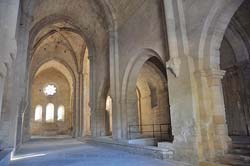 The Silvacane Abbey church is aligned to the east in the classical manner. Unlike its two sister abbeys, Thoronet and Senanque, the Silvacane Abbey church has a main entrance door centered on the western end.
The Silvacane Abbey church is aligned to the east in the classical manner. Unlike its two sister abbeys, Thoronet and Senanque, the Silvacane Abbey church has a main entrance door centered on the western end.
The Dormitory
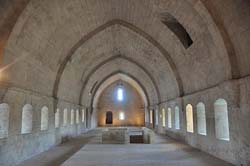 The Monk's dormitory of Silvacane Abbey is on the upper level at the northeastern corner. Entry is up the steps from the north transept of the church
The Monk's dormitory of Silvacane Abbey is on the upper level at the northeastern corner. Entry is up the steps from the north transept of the church
The Cloister
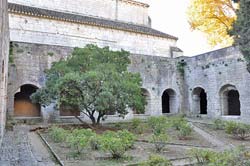 The cloister forms an enclosed courtyard in the center of the Abbey, surrounded by the cloister aisles on all four sides. The cloister aisles are the passages between the church, the dormitory and other parts of the Abbey.
The cloister forms an enclosed courtyard in the center of the Abbey, surrounded by the cloister aisles on all four sides. The cloister aisles are the passages between the church, the dormitory and other parts of the Abbey.
Chapter House
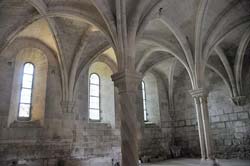 The Senanque Abbey chapter house (Salle Capitulaire) opens off the eastern cloister aisle. This is where the monks met every morning to read one chapter of the Benedictine Rule. Issues concerning life in the monastery were also discussed here with the father abbey and the monks made public confessions.
The Senanque Abbey chapter house (Salle Capitulaire) opens off the eastern cloister aisle. This is where the monks met every morning to read one chapter of the Benedictine Rule. Issues concerning life in the monastery were also discussed here with the father abbey and the monks made public confessions.
Monks' Room
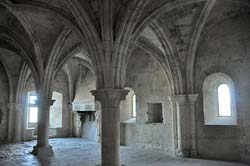 The Monks' Room (Salle des Moines) is on the east side of the cloister aisles, just north of the chapter house. Here the monks pursued their intellectual work and copying manuscripts.
The Monks' Room (Salle des Moines) is on the east side of the cloister aisles, just north of the chapter house. Here the monks pursued their intellectual work and copying manuscripts.
This was the only heated room (le chauffoir) in the abbey, with a fireplace in the corner of the room.
Refectory
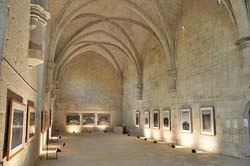 The Refrectory (Réfectoire) was the long dining room along the north side of the cloister aisles, aligned parallel to the cloister because of the slope of the ground. Originally built at the end of the 13th century, this room is a Gothic reconstruction done at the end of the 14th-century.
The Refrectory (Réfectoire) was the long dining room along the north side of the cloister aisles, aligned parallel to the cloister because of the slope of the ground. Originally built at the end of the 13th century, this room is a Gothic reconstruction done at the end of the 14th-century.
High rose windows and tall bay windows, all with stained glass panels, provide a beautiful light to the room. The Refrectory is currently used as an art gallery for the visitors to the abbey.




 After 25 years online, I've decided to remove all Ads from my one-man web Provence Beyond. If the content is enjoyable or useful to you, I would really appreciate your support.
After 25 years online, I've decided to remove all Ads from my one-man web Provence Beyond. If the content is enjoyable or useful to you, I would really appreciate your support.